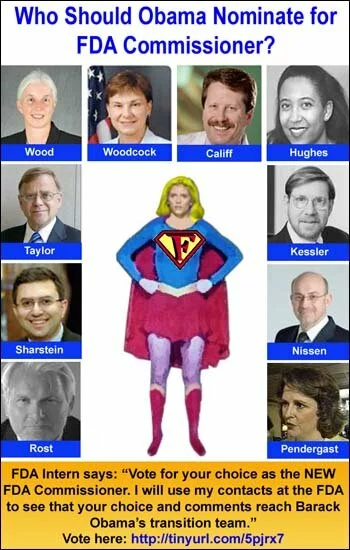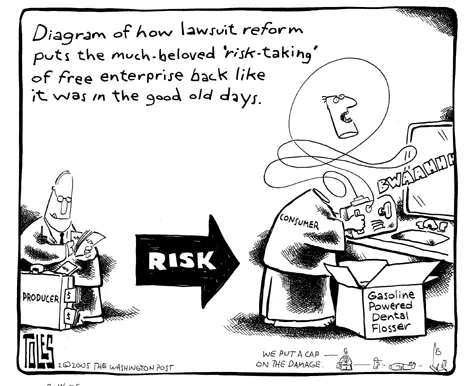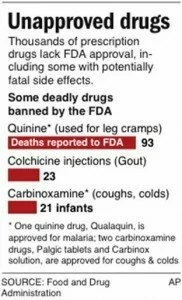 An Associated Press analysis last week concluded that millions of Americans are being prescribed drugs — including those covered under Medicaid — that have never been reviewed by the FDA for safety and effectiveness. The FDA admits there may be thousands of such drugs on the market. Reports the AP:
An Associated Press analysis last week concluded that millions of Americans are being prescribed drugs — including those covered under Medicaid — that have never been reviewed by the FDA for safety and effectiveness. The FDA admits there may be thousands of such drugs on the market. Reports the AP:
“At a time when families, businesses and government are struggling with health care costs and 46 million people are uninsured, payments for questionable medications amount to an unplugged leak in the system … But the FDA estimates they account for 2 percent of all prescriptions filled by U.S. pharmacies, about 72 million scripts a year.”
This isn’t a new problem — most of the drugs in question have been on the market for five decades or more — but it’s a story that gets more galling over time. The history is, it was only in 1962 that the FDA began reviewing new medications for safety. Medications already on the market at that time were to be vetted by the FDA eventually … but 46 years later, thousands of meds have never been reviewed at all.
According to the AP:
It might be easier to sort things out if the FDA compiled a master list of unapproved drugs, but the agency hasn’t. FDA officials say that would be difficult because many manufacturers do not list unapproved products with the agency. Yet, the AP found many that were listed — a possible starting point for a list.
Among the drugs the AP’s research identified were Carbofed, for colds and flu; Hylira, a dry skin ointment; Andehist, a decongestant, and ICAR Prenatal, a vitamin tablet. Medicaid data show the program paid $7.3 million for Carbofed products from 2004 to 2007; $146,000 for Hylira; $4.8 million for Andehist products, and $900,000 for ICAR…
Federal law does not provide fines for selling unapproved drugs, and criminal prosecutions are rare.
This is another instance where it’s in your interest to do your own research on the drugs you are prescribed. Many doctors and pharmacists are unaware that drugs they are prescribing and dispensing have never been vetted by the government — but you can find out for yourself with a little Internet searching.
Drugs@FDA is an FDA Web site that allows you to search government-approval information on “most of the drug products approved since 1939.” Additionally, the site includes “the majority of labels, approval letters, reviews, and other information available for drug products approved from 1998 to the present.”
The FDA offers other resources for determining if a drug is approved here.
For FDA updates and AP news on 200 of the most commonly prescribed drugs, you can also check out eDrugSearch.com’s Online Pharmacy Dictionary.
John Mack of Pharma Marketing News is asking who should be the next FDA commish. His survey walks you through some of the top contenders, including:
- Robert Califf, vice chancellor for clinical research and professor of medicine in the Division of Cardiology at Duke.
- Dora Hughes, Health Policy Advisor to Senator Barack Obama.
- David Kessler, former FDA Commissioner.
- Steve Nissen, cardiologist at Cleveland Clinic.
- Mary Pendergast, industry consultant who was a former associate FDA Commissioner under David Kessler.
- Peter Rost, former Pfizer VP of Marketing, now a blogger.
- Joshua Sharfstein, commissioner of the Baltimore City Health Department.
- Mike Taylor, former Deputy FDA Commissioner under Clinton
- Susan Wood, the former head of women’s health at FDA, who resigned in protest after the delay in switching the morning-after pill over-the-counter.
- Janet Woodcock, Center for Drug Evaluation & Research Director
So what are you waiting for? Vote now!
From the Wall Street Journal Law Blog:
After the arguments wrapped up in Wyeth v. Levine…we called around and spoke to a couple lawyers who were present at the scene. Based on those convos, and an AP report, we were able to cobble together an overview of the back-and-forthing…
…the Justices took issue with Wyeth’s argument that it couldn’t update its label to add stronger warnings without first getting FDA approval. “Wyeth could have gone back to the FDA anytime†to update the label, said Justice Souter. “And it simply didn’t do it.â€
But Seth Waxman, who argued the case for Wyeth, argued … that, when the FDA has specifically considered the risk involved and rejected the sort of warning that Diana Levine seeks, then the claim is preempted because it directly conflicts with the FDA’s own determination.
The plaintiffs, on the other hand, argue that the FDA regulations are merely a floor, not a ceiling, and that state tort law augments those regulations by providing companies with incentives to inform of all possible risks…
Indeed, when Justice Kennedy asked Levine’s lawyer when preemption should apply, the lawyer said that if the FDA had adequately weighed the risks and benefits … and included those details on the label, then his client wouldn’t have a case. However, the lawyer argued, those details weren’t provided. Therefore, preemption doesn’t exist in this case.
Sounds to me like the Levine argument is more than reasonable. She was awarded $6 million after having her arm amputated — which also sounds reasonable.
Why on earth would ANYONE favor government deregulation AND the de-fanging of our tort system? Without both of these protections, consumers are completely powerless when they are injured by the actions or negligence of large corporations.
Please, don’t buy into this nonsense about tort reform being about people who are awarded $100 million dollars for spilling hot coffee on themselves. That just doesn’t happen — and in the very rare instance when it does, the monetary award is always subsequently reduced or eliminated (even if this reduction doesn’t make the headlines.)
If you want to know how hard it is for people to collect money from large corporations or wealthy individuals who have wronged them, look at the Exxon Valdez case — or the O.J. Simpson civil case for that matter. Neither Exxon nor Simpson have paid a dime since those big-money judgments made the news.
The tort reform movement is funded by large corporations. They fund tort reform because they want to make more money, plain and simple. If you buy into it, you’re not reducing your costs — you’re just increasing their margins. You’re playing into their hands.
A decision on Wyeth v. Levine is expected this week. Kaiser has a great overview of the case here.
People’s Pharmacy is an excellent syndicated column that you should definitely check out if you aren’t already reading it. If it’s not in your hometown paper, you can find them online here. The writers, Joe and Terry Graedon, have been impassioned advocates for healthcare consumers for more than 30 years.
(Here’s what the Graedons have to say about Canadian pharmacies, by the way: “The FDA won’t admit it, but buying drugs from legitimate Canadian pharmacies may be safer than buying from the drugstore down the block.”}
I bring up the Graedons because their column recently reminded me about a very important issue that had fallen off my radar screen. Today, the U.S. Supreme Court is scheduled to begin hearing arguments on Wyeth v. Levine, a case that could leave consumers powerless to get redress if they are injured (or worse) by medications that don’t work as promised.
Washington oddsmakers predict the pro-business justices will rule in favor of the drugmaker Wyeth over Diana Levine (pictured). Here’s an excerpt of the Graedons’ column:
Does Food and Drug Administration approval guarantee safety? If the Supreme Court rules as expected, patients might have no legal recourse if they are harmed by an FDA-approved medicine. The case that will soon be decided by the Supreme Court involves a musician who was treated for a migraine. The medicine that was injected to stop her nausea was administered incorrectly. This led to gangrene of her arm and eventual amputation just below the elbow.
The Vermont Supreme Court upheld a Superior Court finding that the drug company was negligent because it did not provide adequate warning about the injection process. The manufacturer maintains that the FDA approved the prescribing information that was used and therefore the drug company has no liability.
In other words, FDA approval could get the pharmaceutical firm off the hook for any complications that might arise…This case could well set a precedent for all future pharmaceutical-related litigation. If FDA approval means that drug companies are not liable, then there will be no recourse if someone experiences a serious or even deadly adverse reaction.
Anyone who’s been watching the machinations of Big Pharma and the Bush Administration over the past decade already knows the following:
– The FDA has had its staff and other resources dramatically slashed in the past eight years.
– Not coincidentally, the FDA has been involved in more scandal for approving dangerous drugs than at any time since its formation.
– The FDA is infested with Big Pharma lobbyists, further tying its hands to adequately regulate potentially dangerous medications.
In this environment, where Big Pharma is pushing drugs through the FDA with less resistance than ever, where staff is stretched thin and conflicts of interests are pervasive, do we really want to give Big Pharma a free pass if the FDA approves (as it inevitably will) another drug that turns out to be harmful?
I sure don’t.
FDA approval should be the floor, not the ceiling, when it comes to consumer protection.
You can read more about the Levine case — and how we reached this point — here. If you’re not already familiar with the case, I’m guessing it will make your blood boil.
 Can you hear that? It’s the sound of political spinning, twirling and flip-flopping — followed closely by backbones turning to mush.
Can you hear that? It’s the sound of political spinning, twirling and flip-flopping — followed closely by backbones turning to mush.
In the face of a relentless disinformation campaign (and lots of campaign donations) by the pharmaceutical industry and its front groups over the past several months, both Barack Obama and John McCain are showing strong signs of backing down — in unison — from their pledges to legalize Canadian drug reimportation if they are elected.
Call them the Flying Wallendas of Flip-Flops. For guys who claim to be about change — with McCain having the nerve to boast that he “took on the drug industry” in his campaign ads — they are beginning to spew the same old song and dance when it comes to prescription drug policy. I suppose that’s because Big Pharma dollars aren’t red or blue; they’re green.
Reports Reuters, which spoke to an adviser for each candidate:
Neither adviser said their candidate had abandoned reimportation, but had realized it would be more difficult … Groups representing brand-name and generic drugmakers, including GPhA, oppose reimportation, saying it could allow more unsafe products into the country.
So, why the impending flip-flop?
Big Pharma has been working overtime to scare people into thinking Canadian drugs aren’t safe. What is their argument in making this charge?
That the FDA is incompetent to do its current job — and certainly can’t be expected to properly regulate drugs coming in from foreign countries.
After the massive FDA failures of the past couple of years, it’s hard to argue that the FDA has its act together. But let’s take a step back for a moment.
The FDA was one of America’s most trusted and respected regulatory agencies in the ’70s, as public opinion polls at that time made clear. Then, first in the ’80s and then again in this decade, politicians favoring deregulation (and funded by the pharmaceutical industry) slashed the FDA’s staff, budget and power. By the end of Bush’s first term, the agency was a shell of its former self.
And now we wonder why we’re having problems with drugs coming in from China?
If you are naive enough to believe that Big Pharma is actually concerned about the safety of the public (rather than protecting its profits) when it opposes Canadian drug reimportation, ask yourself this question: Is Big Pharma in favor of the federal government rebuilding a strong — and independent — FDA?
The answer is no. It’s not. It just wants to scare the public away from Canadian drugs. When Obama and McCain complete their flip-flops, Big Pharma will have won. And then it’s back to business as usual.
I’m sorry if this sounds cynical — but this stuff has been happening too long to sugar-coat. We’ve been in the grip of the pharmaceutical industry for far, far too long.
Ironically, The Wall Street Journal is now wondering if there is still even demand for Canadian drugs among U.S. consumers, given the discontinuation of some state and municipal reimportation programs for lack of interest.
The reality is, there’s very strong public demand for Canadian drugs — which persists in the face even of Big Pharma’s most shameful scare tactics. Programs like the one the Journal cites in Boston failed because consumers don’t need the government involved in this way; they can purchase drugs from Canada directly using tools like PharmacyChecker and eDrugSearch.com to verify a pharmacy’s licensing and accreditations.
And that’s what they do. It’s also what they’ll continue to do in 2009 and beyond, in either an Obama or McCain administration.
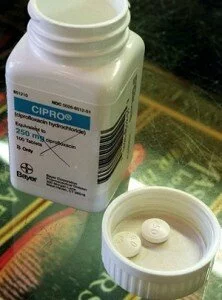 Today’s Los Angeles Times has a feature analyzing the FDA’s so-called “black box” warning labels – and why some risky drugs receive them while others don’t.
Today’s Los Angeles Times has a feature analyzing the FDA’s so-called “black box” warning labels – and why some risky drugs receive them while others don’t.
The article specifically poses this question:
Cipro and the similar antibiotics are given the agency’s strictest label, while epilepsy drugs Lyrica, Depakote and Topamax may have escaped. Why?
There’s nothing earthshaking in the piece — the FDA’s decisions are presented as more or less appropriate — but for those interested in how the FDA does its job, it’s a worthwhile procedural. The story is accompanied by a glossary of drug regulation terms.
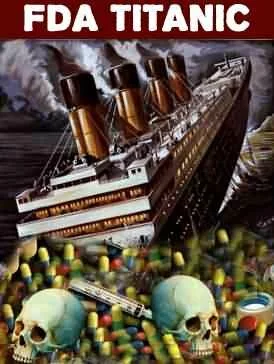 I wrote the other day about the hypocrisy –not to mention true gall — that pharma apologists like Peter Pitts have shown in their attacks on Canadian drug reimportation.
I wrote the other day about the hypocrisy –not to mention true gall — that pharma apologists like Peter Pitts have shown in their attacks on Canadian drug reimportation.
Essentially, Pitts argues that Americans should not be permitted to buy Canadian drugs because the FDA is incompetent to regulate these imports and keep the public safe. This is now the pharmaceutical industry’s leading argument against Canadian drugs.
The exquisitely painful irony here, of course, is that Big Pharma has been leading the charge to de-fang (and then de-gum and de-tongue) the FDA for decades now. I like the analogy I used the other day, so I’ll use it again: It’s like a child murdering his parents — then begging the court for mercy because he’s an orphan.
All of which brings forth the larger question, “Who killed the FDA?”
Was it Ronald Reagan with a candlestick in the library? A Big Pharma lobbyist with a lethal injection in the spin room? Or WHO, exactly?
I came across an article by Greg Anrig in The American Prospect, via the Campaign for America’s Future, that provides a useful history lesson. Here’s an excerpt:
Charting the phases of the FDA’s decline lays bare the responsibility borne by movement conservatism. The first phase was the two terms of the Reagan presidency, when the FDA’s staff declined by 30 percent.
After a reprieve from 1988 to 1994, when more moderate presidents and a Democratic Congress provided ample boosts in the agency’s budget and staffing, the FDA’s garroting resumed with a vengeance in the wake of the 1994 Republican landslide that catapulted Gingrich to the House Speaker’s chair. He led a highly effective jihad against the agency, pushing to privatize many of its activities.
The onslaught continued under George W. Bush and the Republican Congress. From 1994 to 2007, according to former FDA chief counsel Hutt, the agency’s appropriated personnel declined from 9,167 to 7,856, while its funding increased by only two-thirds of the amount that would have been needed to keep up with inflation…
Ironically, Reagan’s anti-FDA movement got traction with his claims that the FDA was effectively “murdering” Americans by spending too long approving needed drugs. Of course, cutting agency personnel by 30 percent doesn’t necessarily speed things along; it just spreads its resources more thinly, so that more mistakes are made, the agency gets blamed, and more resources are cut to punish the agency as a result.
It’s an irrational cycle that ends with, “Will the last FDA employee hand the keys to Big Pharma on his way out?” But so far, it’s worked like a charm. As Anrig writes:
Back in the 1970s, the FDA ranked among the most respected public agencies, with a public confidence rating of 80 percent. By 2000, that level had dropped to 61 percent; last year, it was just 36 percent. Quite clearly, the conservative movement has accomplished its mission of causing the general public to share its hostility toward what was once an admired governmental institution.
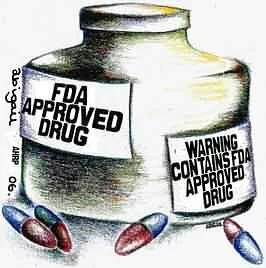 You might think Big Pharma would give up its longstanding fight against Canadian drug reimportation — now that both John McCain and Barack Obama vocally support it (not to mention 80 percent of the American public).
You might think Big Pharma would give up its longstanding fight against Canadian drug reimportation — now that both John McCain and Barack Obama vocally support it (not to mention 80 percent of the American public).
You’d be wrong.
As it turns out, Big Pharma believes it has a trump card in its bid to maintain its inflated drug profits by keeping out competition from abroad. That trump card: the incompetence of the FDA.
The argument is outlined in this op-ed piece by Peter Pitts, president of the Center for Medicine in the Public Interest, which is funded by Big Pharma among other sources. Says Pitts:
Several lawmakers have proposed allowing Americans to buy drugs from abroad. Since many brand-name pharmaceuticals are available at a lower price in foreign countries, many believe that legalizing drug importation would help lower U.S. healthcare costs.
All of the plans to lift the ban, including ones by Barack Obama and John McCain, stipulate that only “safe” drugs will be permitted into the country.
It would be up to the FDA to make sure all imported drugs are safe and effective.
As the salmonella case illustrates all too clearly, such a promise would be almost impossible to keep.
Isn’t that beautiful? Big Pharma, which has advocated and overseen the gutting of the FDA’s regulatory capabilities over the past two decades, now says, “Sorry, but the FDA just doesn’t have the regulatory capabilities to monitor drug imports.”
That’s chutzpah, baby.
Of course, it’s not a lot different from what eDrugSearch.com faced when we appeared on the Mike and Juliet show last month. One of the other folks on stage was representing the National Association of Boards of Pharmacy (NABP). The NABP was touting its own anti-import research — also funded by Big Pharma.
Of course, the irony of saying that imports aren’t safe — and that the FDA is incompetent to regulate them — is that many good ol’ American drugs sold at good ol’ American pharmacies are manufactured in China. We live in a largely deregulated global economy today — and this is the case whether you order your medications from U.S. or Canadian pharmacies. In most if not all cases, the drugs you receive from a properly licensed Canadian pharmacy are identical to those you would receive from a U.S. pharmacy.
So, yes, the FDA needs an overhaul as a regulatory body — that’s been made evident time and again in recent years. That means we need to do two things:
1. Extract the corrupting tentacles of Big Pharma from the FDA;
2. Dramatically increase funding to the FDA to ensure the organization has the resources to keep the public safe.
Sadly, Big Pharma — their protestations that they’re concerned for your safety to the contrary — wants NEITHER of these things to happen.
If it were up to them, the FDA would go away all together. Then you’d have to trust Big Pharma to “keep you safe” — and keep paying them protection money for the privilege.
Image source
Comedienne Tracey Ullman debuted a new series on Showtime this season, and one of her funniest bits was making fun of FDA policy that — officially, at least — forbids American consumers from purchasing drugs from Canadian pharmacies. Check it out:
It’s funny stuff. Of course, the reality, for those familiar with the law, is that the FDA permits U.S. citizens to order drugs in supplies of 90 days or less without fear of confiscation. It’s similar to the military’s “don’t ask, don’t tell” policy for gay soldiers.
Though it wouldn’t happen in real life, Ullman’s skit does point out the true absurdity of the FDA’s official stance on Canadian drug reimportation. Fortunately, both John McCain and Barack Obama oppose the FDA’s backward thinking and have announced plans to change the policy to encourage consumers to buy drugs from Canada and force a little price competition — which as we all know, is long overdue.
‘Cause Big Pharma sure isn’t coming up with anything. According to PRWeek:
Only twice in the past three decades has the Food and Drug Administration approved fewer than the 18 it gave a thumbs up to in 2007. Compare that to 53 drugs in 1996. Oddly, the FDA said they hadn’t finished tallying numbers for the year and wouldn’t release its final statistics until March. Pipelines are dry indeed.
-
-
Search Blog Posts
-
Save Even More Money!
-

-
Trending Content
-
Watch our YouTube Video
-
Categories
Big Pharma Buy prescriptions online Canadian drugs Drug costs Drug reimportation Drug safety eDrugSearch.com FDA Health 2.0 Healthcare100 Healthcare blogs Healthcare solutions Low-cost drugs Medicare Part D Merck Online pharmacies Online pharmacy safety Pfizer Pharma bloggers Pharmaceutical companies Pharmaceutical marketing Pharma cheerleaders Prescription drug abuse Prescription drug prices Prescription drugs Prescriptions Wal-Mart drug plan -
Blogroll
- Bullet Wisdom
- Bulverde Business Directory
- Christian Counseling San Antonio Tx.
- Christian Schools in San Antonio Texas
- Christian Social Network
- Christians United for Israel
- DrugWonks.com
- Eye on FDA
- GoozNews
- Health 2.0
- Hunting Forum
- In the Pipeline
- Jesus Christ Our King
- John Hagee Ministries
- Kevin, M.D.
- Local Search Marketing
- My $299 Website
- Pharm Aid
- Pharma Marketing
- PharmaGossip
- Pharmalot
- San Antonio Asphalt
- San Antonio Life Insurance
- San Antonio Pressure Washing
- Storage New Braunfels Tx
- Texas Wildlife Supply
- The Angry Pharmacist
- The Health Care Blog
- The Peter Rost Blog
- World Vision
-
Tags
big pharma Canadian drugs canadian pharmacies canadian pharmacy consumer reports craig newmark divine healing Drug costs drug prices Drug reimportation eDrugSearch.com FDA Fosamax Generic drugs healing scriptures Health 2.0 healthcare reform Hypertension Jehova Rophe Jesus Christ Lipitor Metformin miracles nabp online pharmacy dictionary online prescriptions osteoporosis peter rost Pharmacies pharmacists pharmacychecker pharmacy spam phrma Prescription drugs prescription medication Proverbs 3:5-8 reimportation relenza Roche saving money SSRI swine flu Tamiflu The Great Physician The Lord our Healer -
Recent Tweets
- eDrugSearch Blog Rank on the Healthcare100: http://t.co/VJprL4LZWl [#]
- New blog posting, How to Get Prescription Medication Without Health Insurance - http://t.co/1ZdLavB87d [#]
- 10 Tips for Safer Prescription Drug Use http://t.co/GFnMIN1mCy [#]
- New blog posting, How to Beat High Drug Prices By Comparing Low Cost Pharmacies - http://t.co/fsZ0stNZme [#]
-
Archives
-
Recent Comments
- Heather Sturges on What is the Difference Between Effexor and Cymbalta?
- Lupe Machol on Cost of diabetes drugs has nearly doubled
- Manpower For Hospital In Pune on Why is Medicine Cheaper in Canada?
- Jen on How a Canadian Pharmacy Can Help You Offset Drug Price Hikes
- nino iarajuli on Vending machine dispenses prescription drugs
